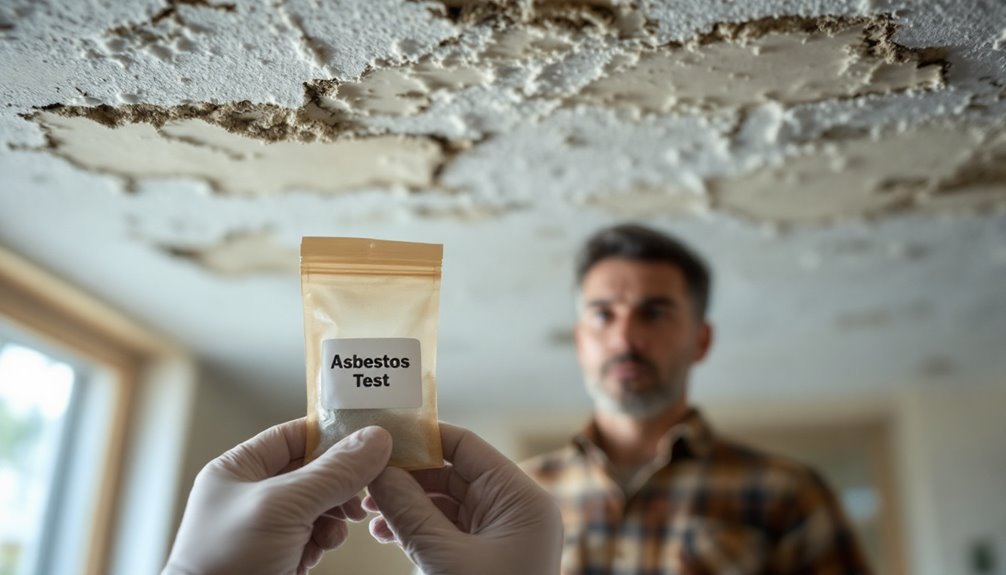To identify asbestos in your home, check areas with materials likely to contain it, like insulation, ceiling tiles, and flooring, especially in properties built before 1980. Look for signs of deterioration, such as cracks or crumbling surfaces. Testing is crucial and should be conducted by professionals to guarantee safety and accuracy since asbestos fibers can pose serious health risks. Attempting to handle it yourself can lead to dangerous exposure. Experts utilize specialized procedures for detection and safe removal, so you should always call professionals if you suspect asbestos. There's much more you can learn about managing asbestos safely.
Understanding Asbestos Risks

Asbestos frequently poses significant risks to health, particularly in older homes where it was commonly used in insulation, flooring, and other building materials. You need to be aware that inhaling asbestos fibers can lead to severe respiratory diseases, including asbestosis and lung cancer. This risk is heightened when asbestos-containing materials are disturbed during renovations or repairs.
Many homeowners hold onto asbestos myths, believing that the material is harmless if left undisturbed. Nevertheless, even non-friable asbestos can become dangerous if it deteriorates or is disturbed. It's essential to understand that asbestos regulations vary by location, but they often mandate strict guidelines for handling and disposing of asbestos-containing materials. Ignoring these regulations can expose you and your family to unnecessary risks.
To protect your freedom and health, consider having your home inspected by certified professionals who can accurately identify asbestos and advise on safe removal if needed. By staying informed and challenging misconceptions, you empower yourself to make the right decisions regarding your home's safety. Remember, taking proactive steps today can prevent potential health hazards tomorrow.
Common Asbestos Locations
Where might you find asbestos lurking in your home? First, check the basement insulation. If your home was built before the 1980s, it's possible that your insulation contains asbestos fibers. This material was frequently used for its fire-resistant properties and thermal efficiency.
Next, examine your ceiling tiles. Asbestos was commonly added to ceiling tiles for soundproofing and durability. If you notice older tiles, especially those with a textured surface, they could contain asbestos.
Furthermore, look at the walls and floors. Asbestos materials may be present in vinyl flooring, adhesive, or in wall plaster. In attics, you might find asbestos in insulation or as part of roofing materials.
Don't forget to inspect other areas like ductwork, furnace insulation, and any popcorn ceilings, all of which may likewise harbor asbestos.
If you suspect asbestos in any of these locations, it's vital to avoid disturbing the materials. Disturbance can release harmful fibers into the air, putting you and your family at risk. Always consult with experts for proper assessment and safe removal. Prioritizing safety is essential when dealing with potential asbestos hazards.
Signs of Asbestos Presence

When evaluating your home for asbestos, focus on common material types like insulation, floor tiles, and textured ceilings. Conduct a visual inspection to identify any damaged or deteriorating materials that may contain asbestos. Recognizing these signs early can help you take appropriate action to guarantee safety.
Common Material Types
In older homes, you might encounter various materials that could potentially contain asbestos, especially if they were installed prior to the 1980s. Understanding the common material types associated with asbestos is essential for effective material identification.
Insulation materials, such as pipe insulation and thermal insulation, often contain chrysotile, one of the most prevalent asbestos types. Ceiling tiles and floor tiles manufactured before the 1980s frequently contain asbestos, especially those that are textured or have a patterned appearance.
Moreover, spray-applied fireproofing and decorative plaster can harbor asbestos fibers. You should likewise be cautious with roofing materials, including shingles and roofing felt, as these may contain asbestos for added durability and fire resistance.
Lastly, certain types of cement products, such as siding and sheets, often contain asbestos to improve strength and water resistance. It's important to remember that if you suspect any of these materials contain asbestos, you shouldn't attempt to remove or disturb them on your own. Instead, contact certified professionals for proper testing and safe removal. This approach guarantees your freedom from the health risks associated with asbestos exposure.
Visual Inspection Tips
Often, a thorough visual inspection can reveal potential signs of asbestos presence in your home. Start by following an inspection checklist that highlights common materials likely to contain asbestos, such as textured ceilings, floor tiles, and insulation around pipes. Look for visual cues like frayed or damaged materials; deterioration may indicate the material is friable, meaning asbestos fibers can easily become airborne.
Pay close attention to areas in your home built before the 1980s, as these are more likely to contain asbestos products. Inspect for any signs of water damage or repairs, as these can disturb asbestos-containing materials, increasing the risk of exposure. If you notice any suspicious materials, avoid touching or disturbing them.
Remember to note the condition of these materials. Intact materials may pose less risk than damaged ones. Always prioritize safety—if you suspect asbestos presence, it's essential to call in experts who can conduct proper testing and removal. Your home's safety is paramount, and recognizing these visual cues can empower you to take the necessary steps toward a safer living environment.
Testing for Asbestos
Though you might suspect the presence of asbestos in your home, testing is the only definitive way to confirm its existence. Asbestos testing involves collecting samples from suspected materials and analyzing them in a laboratory. This process is essential since asbestos fibers are microscopic, and their presence can pose serious health risks.
Here's a quick overview of common sampling techniques:
| Technique | Description |
|---|---|
| Bulk Sample | A small piece of material is collected for analysis. |
| Air Sampling | Air tests measure fiber concentration in the atmosphere. |
| Tape Sample | Adhesive tape captures fibers from surfaces. |
| Vacuum Sampling | A vacuum device collects materials from floors or surfaces. |
When you decide to proceed with asbestos testing, it's best to hire professionals who follow strict protocols to guarantee safety and accuracy. They'll utilize proper protective gear and methods to avoid further contamination. By entrusting this task to experts, you can ascertain that sampling techniques are executed correctly, leading to reliable results and peace of mind.
DIY Inspection Tips

After confirming the presence of asbestos through testing, you may want to conduct a DIY inspection to identify potential problem areas in your home. Start by gathering an inspection checklist to guide you through the process. Focus on areas where asbestos is commonly found, such as insulation, flooring, and ceiling tiles.
Before you begin, take vital homeowner precautions. Wear protective gear, including gloves, a mask, and goggles, to minimize exposure. Guarantee proper ventilation in the area you're inspecting. It's critical to avoid disturbing materials, as this can release asbestos fibers into the air.
As you inspect, look for signs of wear or damage, such as cracks, peeling, or crumbling. Document your findings meticulously, noting the location and condition of suspect materials. If you encounter any questionable materials, mark them clearly to avoid accidental disturbance later.
When to Call Professionals
Knowing when to call in professionals can be vital for your safety and the integrity of your home. If you suspect asbestos presence, there are specific scenarios where you should definitely consult an expert. Here's when you should reach out for an expert assessment:
- You've identified damaged materials that might contain asbestos.
- You're planning a renovation or demolition project in an older home.
- You feel unsure or overwhelmed by your DIY inspection findings.
In these situations, it's important to rely on trained professionals who specialize in asbestos identification and abatement. They have the tools and expertise to accurately assess the situation, ensuring your home remains a safe space. Remember, asbestos-related tasks can be risky, and mismanagement can lead to severe consequences.
Don't hesitate to seek professional help if you find yourself in these scenarios. An expert assessment not only guarantees your safety but furthermore provides peace of mind, allowing you to focus on enjoying your home without the fear of hidden dangers. Prioritizing your health and that of your loved ones is the ultimate form of freedom, so take action when necessary.
Health Implications of Asbestos

Identifying asbestos in your home is just the first step; understanding its health implications is of similar importance. Asbestos exposure poses serious risks that you shouldn't underestimate. When disturbed, asbestos fibers can become airborne, leading to inhalation and potential long-term health issues.
Prolonged exposure to these fibers is linked to several detrimental lung diseases, including asbestosis, lung cancer, and mesothelioma. Asbestosis, a chronic condition, results from scarring of lung tissue because of fiber inhalation, causing breathing difficulties. Lung cancer, often aggravated by smoking, can develop after years of exposure, with symptoms manifesting only in advanced stages. Mesothelioma, a rare but aggressive cancer, primarily affects the lining of the lungs and is almost exclusively caused by asbestos exposure.
It's essential to recognize that even minimal exposure can be harmful, particularly for children and individuals with pre-existing respiratory conditions. If you suspect asbestos in your home, prioritize your health and well-being by consulting professionals who can provide expert guidance. Understanding these health implications empowers you to take the right steps towards a safer living environment.
Safe Removal Strategies
When it comes to safely removing asbestos from your home, it's crucial to follow established guidelines to minimize health risks. Attempting to tackle this hazardous material without proper knowledge and training can lead to severe consequences. You should consider professional help, but if you choose to remove it yourself, adhere strictly to safety protocols.
Here are some effective removal techniques to keep in mind:
- Wear appropriate protective gear: This includes respirators, gloves, and disposable coveralls to shield yourself from fibers.
- Seal off the work area: Use plastic sheeting and tape to prevent the spread of asbestos particles to other parts of your home.
- Wet the material before removal: Dampening asbestos can help reduce airborne fibers, making the process safer.
Always remember that the goal is to protect yourself and your loved ones from exposure. The risks associated with improper removal can lead to long-term health issues. If you're unsure or feel overwhelmed, don't hesitate to reach out to experts who specialize in asbestos abatement. Your safety and peace of mind are worth it.
Conclusion
In your quest to guarantee a safe home, you might feel tempted to tackle asbestos detection and removal yourself. Ironically, the very material meant to insulate your space can likewise pose a deadly risk if mishandled. By calling in the experts, you not only protect your health but additionally avoid turning a simple home project into a hazardous situation. Remember, when it comes to asbestos, a cautious approach is truly the safest strategy.
